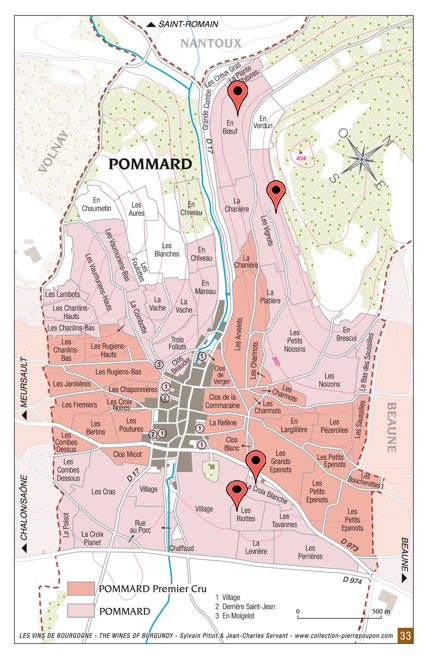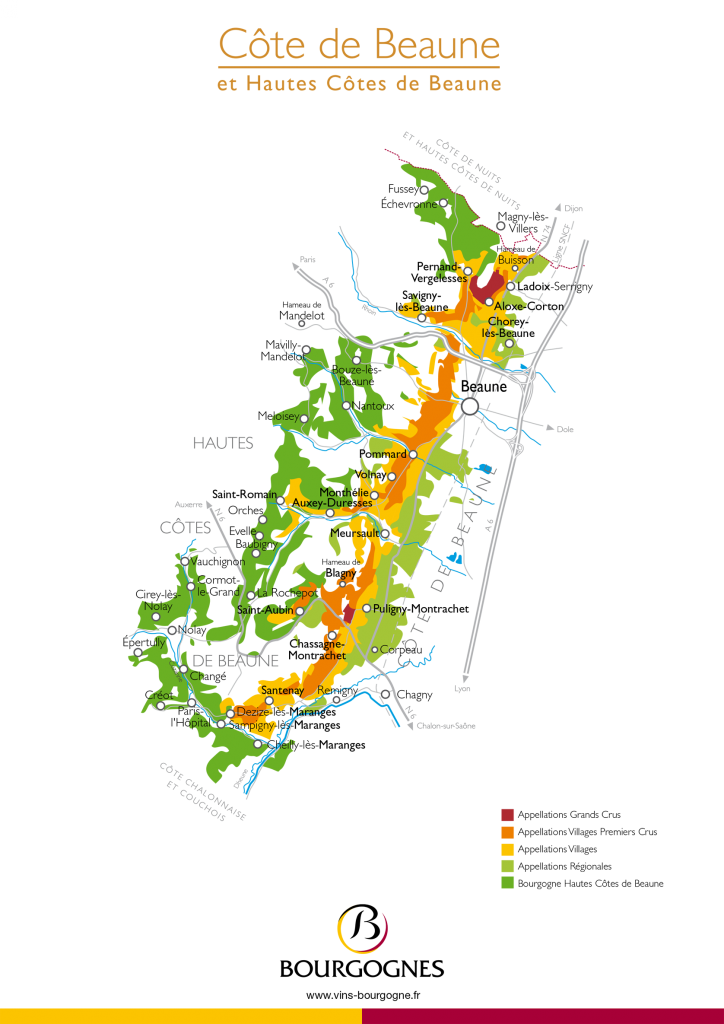Our appellations
POMMARD

Village in the south of the Côte de Beaune with 320ha of vines.
History of the POMMARD appellation.
Considered as “the flower of Beaunois wines” since the Middle Ages, Pommard has always been synonymous with powerful, bouquety wines that can be kept for a long time.
- Place: " vineyards”:
This locality is one of the most famous of the appellation. Its location near the Premier Cru plots of "Les Arvelets" and "La Plâtrière", at the very top of the hillside, hence its name "Les Vignots", i.e. "vines at the top".
- Area: 30a09.
- Number of bottles produced: 1900/year.
- Exposure: due south, altitude of 330 m.
- Steep slope: 34%
- Types of soil: The plot located on a fairly steep hillside and a terroir of white marl with a lot of rock, very little soil on the surface.
- Taste characteristics: deep red in color, the wines have aromas of jammy red fruits and sweet spices. On the palate, they are powerful, warm and complex, with present but fine tannins, and great persistence from its minerality.
- Serving temperature: 15-16°C; it is often desirable to decant recent vintages in order to amplify their aromatic expression.
A cuvée is made from the blend of 3 plots (Les Riottes, la Croix Blanche, les Bœufs).
- Area: 37a6.
- Number of bottles produced: 2400/year
- Serving temperature: 15-16°C; it is often desirable to decant recent vintages in order to amplify their aromatic expression.
Place called: “Les Riottes”:
"Little street" in old French. Located next to the vineyards of the Château de Pommard, which also operates this locality, is distinguished by the quality of its clays.
- Area: 9a50.
- Slope: none.
- Types of soil: Calcareous soil, shallow and very draining Distinguished by the quality of its clays and its low rate of limestone.
- Taste characteristics: Lots of power combined with great finesse, fruity wine with silky tannins combining smoothness and volume in the mouth. Rich, deep and airy at the same time, the wine from Riottes brings its letters of nobility to the final blend.
Location: " White Cross”:
These vines are located very close to Épenots, near the old Pommard station; train leaving Beaune for Bligny sur Ouche.
- Area: 8a70.
- Slope: none.
- Soil types: clay, shallow limestone, silt.
- Tasting characteristics: Ripe fruit wine, creaminess gives way to minerality, straight, precise and strongly structured wines.
Location: " Cows " :
- Area: 19a40.
- Slope: none.
- Soil types: clay, limestone, pebbles.
- Tasting characteristics: Deep red color, limpid with garnet reflections. Intense nose of red fruits with floral notes. Frank attack, aromas of red fruits. The tannic structure is full of elegance.
BURGUNDY HIGH CÔTES DE BEAUNE

Born in 1961, the appellation extends, in Côte d'Or, over 12 communes of the Hautes Côtes and on the heights of 10 communes of the Côte de Beaune. The other part is located in the extension, in the department of Saône et Loire.
The estate operates 3ha43 in the town of Meloisey, cradle of the appellation, made up of plots in different localities.
Place called “Le Clou”:
Burgundian variant of “clos”, designating a seigneurial vineyard surrounded by walls.
- Area: 65a60ca.
- Number of bottles produced: 5000/year.
- Exposure: southeast, altitude 350 to 380 m.
- Slope: 10 to 12%
- Type of soil: light, clayey.
- Taste characteristics: this plot produces a colorful wine, with aromas of fresh red fruits, mineral and very tense in the mouth.
- Serving temperature: 15-16°C; it is often desirable to decant recent vintages in order to amplify their aromatic expression.
Place called “La Dalignère”:
- Area: 37a96ca.
- Number of bottles produced: 2900/year
- Exposure: south-east, altitude around 350 m.
- Slope: 3 to 5%
- Soil type: shallow; red earth and fine pebbles.
- Tasting characteristics: the wines from this plot are characterized by a beautiful maturity of fruit, a great complexity on a more melted tannic support.
- Serving temperature: 15-16°C; it is often desirable to decant recent vintages in order to amplify their aromatic expression.
Place called “La Perrière”:
The term "Perrières" refers to the old quarries that have long been near the vineyard.
- Area: 65a47ca.
- Number of bottles produced: about 5000/year
- Exposure: south, altitude about 350 m.
- Slope: 3 to 5%
- Soil type: shallow; red earth and fine pebbles.
- Taste characteristics: the wines from this plot are characterized by a dominance of very ripe red fruits, great complexity on a more melted tannic support. Its mouth is structured, with powerful tannins.
- Serving temperature: 15-16°C; it is often desirable to decant recent vintages in order to amplify their aromatic expression.
Place called “En pussey”:
- Area: 1ha17
- Number of bottles produced: about 9000 bottles/year
- Exposure: south, altitude about 300 m.
- Slope: 3 to 5%
- Type of soil: deep clay, marl and pebbles on the surface
- Taste characteristics: the wines from this plot are characterized by a dominance of very ripe red fruits and with powerful tannins.
- Serving temperature: 15-16°C; it is often desirable to decant recent vintages in order to amplify their aromatic expression.
Place called “En Matrin”:
- Area: 19a60ca.
- Number of bottles produced: 1500/year.
- Exposure: southeast, altitude 350 to 380 m.
- Slope: 5%
- Type of soil: light, limestone, fine pebbles.
- Taste characteristics: this plot produces a colorful wine, with aromas of fresh red fruits, with a good structure and fine tannins
- Serving temperature: 15-16°C; it is often desirable to decant recent vintages in order to amplify their expression.
Place called “Aux Grandes Raies”:
- Area: 37a60ca.
- Number of bottles produced: approximately 5300/year
- Exposure: south, altitude about 350 m.
- Slope: 3%
- Soil type: shallow; red earth and fine pebbles.
- Taste characteristics: the wines from this plot are characterized by a dominance of very ripe red fruits, great complexity on a more melted tannic support. Its mouth is structured with silky tannins and a tense finish.
- Serving temperature: 15-16°C; it is often desirable to decant recent vintages in order to amplify their aromatic expression.


